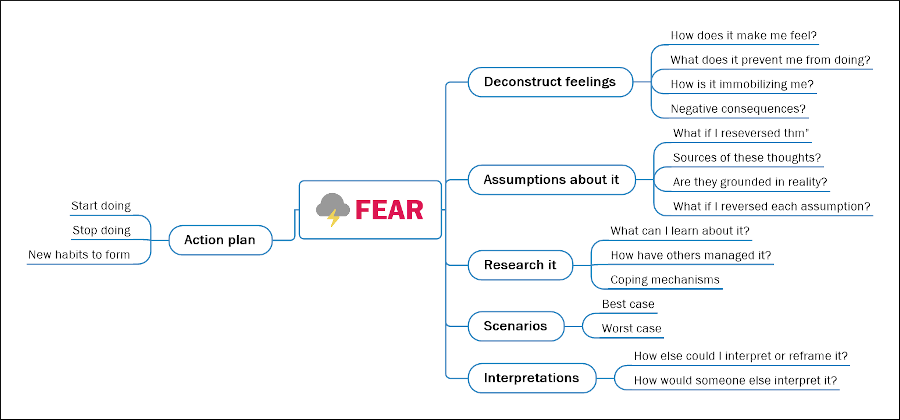
Uncertainty is a breeding ground for fear. With the global pandemic, political unrest, an uncertain job market, societal shifts and challenges all around you, fear seems to be running rampant today. But what if you could face your fears by mapping them out?
While mind mapping definitely isn’t a substitute for psychological counseling, it can be a useful tool to help you explore the fears that darken your mind and hold you back from happiness.
Here are some of the ways you can use a mind map to view a fear from different perspectives and brainstorm more productive thoughts and behaviors to minimize its effects on your life.
Deconstruct your feelings: Do a brain dump of your feelings about your fear. Don’t worry about organizing and arranging your thoughts at first. You can do that later. For now, just let your thoughts and feelings pour out into your mind map.
Ask yourself questions that help you disassemble your fear into its component parts. I’ve listed four of them in the mind map below:
- How does it make me feel?
- What does it prevent me from doing?
- How is it immobilizing me?
- What negative consequences is it causing in my life?
Feel free to come up with your own questions. List them as subtopics and then explore the answers to each of them. Go into as much detail, adding as many layers of subtopics as you need, to describe your feelings out about your fear. There are no “wrong” answers here – you’re simply unpacking your fear to learn more about it.
Map your assumptions: What assumptions are you making about this fear and the grip it has on your thinking? What are the sources of these assumptions? Do they come from your peer group? Social media? Are they based on reality? What if you reversed each assumption? Explore what it would be like if the opposite was true.
Research it: Study your fear. Learn everything you can about it and add your learning to your mind map. How have others learned to handle this fear? What coping mechanisms or treatments seem to work well to minimize its effects?
Scenarios: What’s the worst that could happen if what you fear came to pass? What’s the best that could happen if it didn’t? Explore both scenarios in your mind map. Working through these scenarios can help you to be more realistic about the positive and negative consequences of your fears. Keep in mind that the majority of things we fear in our minds will never actually happen.
Interpretations: How else could you potentially interpret or reframe this fear? How could you see it in a different context? How would someone else interpret it? Pick someone specific – a trusted friend or family member, a famous thinker from history or a subject matter expert who is familiar with your fear and its potential interventions. How would they see it in a different light?
Action plan: After you’re done deconstructing your fear, think about what you’re going to do differently to minimize or eliminate its grip on your thinking. What new habits will you develop to make this possible? How will you reframe your thinking so when this fear enters your mind once again, you’ll approach it in a more constructive way?
It’s up to you now
This visual thinking exercise isn’t a complete prescription for tackling your fears. My goal is to arm you with a number of ways you can look at your fear through fresh eyes, a new perspective, a more creative mindset. It’s purpose is to help you learn more about the fear so you can better understand and mitigate it.
Feel free to ask your own questions. Devise your own thinking exercises to “go deeper” into your exploration. Never stop reading and learning about your fears. Capture what’s useful and helpful, and incorporate it into your approach.
And always remember: You have at your disposal the world’s most powerful thinking tool. Use it to explore your hopes, dreams and fears so you can live a happier and more fulfilling life!


Leave a Reply